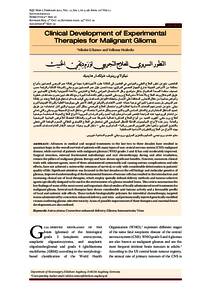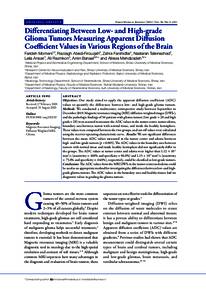وثيقة
Clinical development of experimental therapies for malignant glioma.
المساهمون
Heidecke, Volkmar., مؤلف
عناوين أخرى
التطور السريري للعلاج التجريبي لورم دبقي الخبيث
الناشر
College of Medicine, Sultan Qaboos University.
ميلادي
2011-02
اللغة
الأنجليزية
الملخص الإنجليزي
Advances in medical and surgical treatments in the last two to three decades have resulted in
quantum leaps in the overall survival of patients with many types of non-central nervous system (CNS) malignant
disease, while survival of patients with malignant gliomas (WHO grades 3 and 4) has only moderately improved.
Surgical resection, external fractionated radiotherapy and oral chemotherapy, during and after irradiation,
remain the pillars of malignant glioma therapy and have shown significant benefits. However, numerous clinical
trials with adjuvant agents, most of them administered systemically and causing serious complications and side
effects, have not achieved a noteworthy extension of survival, or only with considerable deterioration in patients'
quality of life. Significant attention was focussed in the last decades on the cell biology and molecular genetics of
gliomas. Improved understanding of the fundamental features of tumour cells has resulted in the introduction and
increasing clinical use of local therapies, which employ spatially defined delivery methods and tumour-selective
agents specifically designed to be used in the environment of a glioma-invaded brain. This review summarises the
key findings of some of the most recent and important clinical studies of locally administered novel treatments for
malignant glioma. Several such therapies have shown considerable anti-tumour activity and a favourable profile
of local and systemic side effects. These include biodegradable polymers for interstitial chemotherapy, targeted
toxins administered by convection enhanced delivery, and intra- and peritumourally injected genetically modified
viruses conferring glioma-selective toxicity. Areas of possible improvement of these therapies and essential future
developments are also outlined.
المجموعة
URL المصدر
الملخص العربي
نتج عن تطور العلاج الطبي والجراحي في العقدين إلى الثلاثة عقود الأخيرة قفرة مهمة في إطالة عمر المرضى المصابين بأنواع مختلفة من الأمراض الخبيثة خارج الجهاز العصبي المركزي، بينما تحسن طول عمر المصابين بورم دبقي (المرحلة الثالثة والرابعة حسب تصنيف منظمة الصحة العالمية) بشكل متواضع. وظل الاستئصال الجراحي والعلاج الخارجي بالأشعة التجزيئية والعلاج الكيماوي عن طريق الفم خلال وبعد العلاج بالأشعة الأساس لعلاج ورم دبقي الخبيث، وأظهر ذلك فائدة كبيرة. ومع ذلك فقد تبين حدوث مضاعفات خطيرة وأعراض جانبية من خلال التجارب المختلفة على الإنسان بإعطائه العوامل المساعدة، وفي الوقت نفسه لم تستطع طرق العلاج هذه من إطالة عمر المريض بل سببت تدهورا كبيرا في نوعية حياته انصب الاهتمام والتركيز في العقد الأخير على بيولوجية الخلية والوراثة الجزيئية لورم دبقي، نتج عن تحسن فهم الصفات الأساسية لخلايا الورم استعمال العلاج الموضعي بشكل أكبر سريريا والذي كان استخدامه عن طريق تحديد المناطق المحتارة ونوع العامل المناسب للورم الذي صمم بشكل خاص لاستعماله في مناطق الدماغ المحيطة بورم ديقي والتي تعاني من انتشار الورم فيها هذه المراجعة تلخص أهم ما توصلت إليه أحدث وأهم الدراسات السريرية لانواع العلاج الحديثة المستخدمة موضعيا لعلاج ورم دبقي، أظهرت العديد من أنواع العلاج المذكورة فعالية ملحوظة ضد الورم والشاكلة المفضلة للأعراض الجانبية الموضعية والعامة، ومن هذه الأنواع البوليميرات القابلة للتحلل البيولوجي التي تستعمل في العلاج الكيماوي الخلالي، السموم الهادفة التي تعطى بالتعزيز الحراري، وأخيرا حقن الفيروس المحور وراثيا - السام لورم ديقي – داخل الورم وحوله، تم بحث الإطار العام لمساحات التحسن بهذه الأنواع من العلاج والتطورات الأساسية المستقبلية
قالب العنصر
مقالات الدوريات


